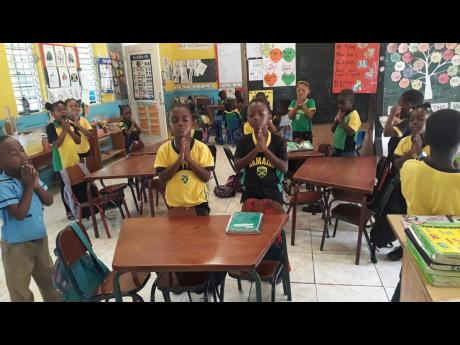Rural schools bat for face-to-face learning
Fatigue from a rugged learning curve with lingering Internet connectivity woes appears to be whittling away at resistance to face-to-face classes amid the coronavirus pandemic.
Less than two weeks after the resumption of the new academic year, the changing tune may be strengthening the Government’s resolve to place in-person classes firmly on the table, with Prime Minister Andrew Holness giving the clearest indication on Thursday that that option could be expanded beyond the handful of schools currently permitted.
“It is quite possible that there could be a modality which allows some schools, and if not some schools in totality, some grades in some schools, to return,” the prime minister said at a Jamaica Labour Party scholarship event.
The telegraphed intention of the Holness administration will likely be welcome news for Joan Blackwood-Simpson, principal of Ebenezer Primary and Infant School in Manchester.
Ebenezer has a population of 82 students, and the principal is lobbying for face-to-face classes because the school can exercise social-distancing and health protocols over its small population.
Manchester’s 350 COVID-19 cases represent a small percentage of the island’s 8,132 infections, according to ministry data as at Thursday, October 15.
Blackwood-Simpson theorises that coronavirus infection risk for her students is low.
“Most of my classes are between 10 and 12 students. I have not heard of any cases in the school surroundings, and we just have about three students from the Mandeville side,” she told The Gleaner recently.
“Our students don’t take public transportation, they walk to school, and the three from the Mandeville area, I would transport them to school.”
Those are factors that will be incorporated into the vulnerability index being crafted by data expert Dr Parris Lyew-Ayee in the State’s initiative to use geoinformatics and demographics to forge a road map for in-person classes.
Because of insufficient tablets and laptops, as well as connectivity problems, the Ministry of Education has offered to deliver printed materials for instruction. However, Blackwood-Simpson foresees that that will not be effective because some parents “are not able to explain to the students”.
Jamaica Teachers’ Association President Jasford Gabriel has said that the union is willing to discuss the viability of face-to-face classes, a sign of a reversal of the hard-line opposition declared weeks ago by various groups representing teachers and principals.
Dr Renee Rattray, educational consultant and founder of Teach Good, Lead Good, firmly believes that a one-size-fits-all ban is not tenable.
“Is it not possible for a small school with lots of land space in rural Jamaica with 100 students who are most vulnerable and without connectivity to be allowed to come to school if all the necessary safety protocols are in place?” she mused on Twitter recently.
‘Myriad of challenges’
Principal of Mt Providence Primary School, Trisha Campbell, agrees.
Most of Mt Providence’s 162 students live within walking distance of the school, a factor she believes would gain ready acceptance among parents for in-person sessions.
Campbell said that before Education Minister Fayval Williams shelved the plan for face-to-face classes, Mt Providence had established a contingency plan to accommodate grades one to three in the morning, with students in the remaining three grades reporting for school later in the day.
The principal cited “a myriad of challenges” related to Internet connectivity because of heavy showers in the rainy season.
It gets even tougher for parents who have one gadget to share among several children in the same household.
“I have parents who have to send their children to their neighbour’s house because of clashes, and then the data is not driving the online sessions,” she said.
In the first week of the new school year that started October 5, only 25 students at Mt Providence had logged on to the approved learning management system and 70 on WhatsApp.
“The rest, we are not seeing online,” she had said.
Now, 93 students of the entire cohort of 162 are registered on Google Classroom, with the others accessing lessons through WhatsApp and phone calls.
But there are still holdouts against face-to-face classes.
Elisa Craig, principal of Woodhall Primary in Clarendon, said that her school is plagued by Internet woes. But even with that handicap, she has reservations about her fewer than 200 students streaming into classrooms.
“Basically, for me, I wouldn’t want them in the classroom. The fact that there is community spread, we can’t say who has it, and the fact that some people are asymptomatic and you can’t tell who they are would be a deterrent,” she said.

